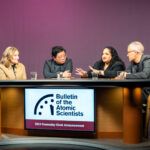Lessons from Hiroshima and Nagasaki: The most exposed and most vulnerable
By David Richardson | May 1, 2012
Because of its scope, the Life Span Study of Japanese atomic-bomb survivors has become highly influential and widely accepted by regulators, policy makers, and courts of law. The usefulness of the study in regard to calculating excess cancer risk, however, should not disguise its limitations. The Life Span Study examines survivors, but not those who died in the years immediately following the Hiroshima and Nagasaki bombings. The study design therefore intentionally omitted frail people—including the very young and the very old—who may have been especially vulnerable to radiation. Regulators and risk assessors need to be aware of this shortcoming and to supplement Life Span Study results with information from studies that focus on those most vulnerable to radiation. A failure to do so may result in an underestimate of the harm caused by radiation, particularly at low doses.
Together, we make the world safer.
The Bulletin elevates expert voices above the noise. But as an independent nonprofit organization, our operations depend on the support of readers like you. Help us continue to deliver quality journalism that holds leaders accountable. Your support of our work at any level is important. In return, we promise our coverage will be understandable, influential, vigilant, solution-oriented, and fair-minded. Together we can make a difference.
Issue: Bulletin of the Atomic Scientists Volume 68 Issue 3
Keywords: Hiroshima, Nagasaki, atomic bomb, cancer, life span study, radiation, survivors
Topics: Uncategorized















